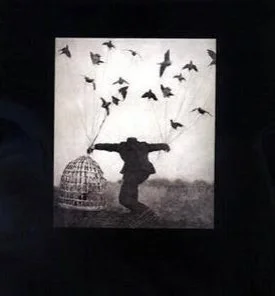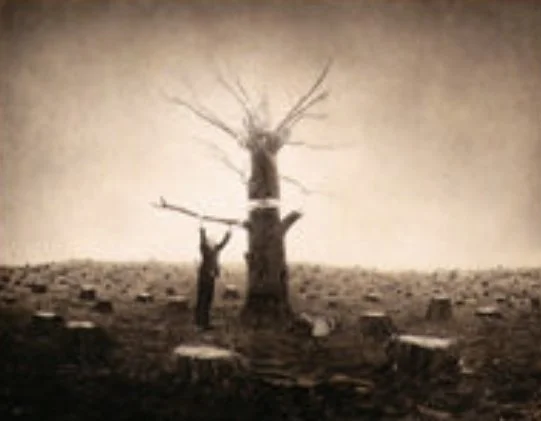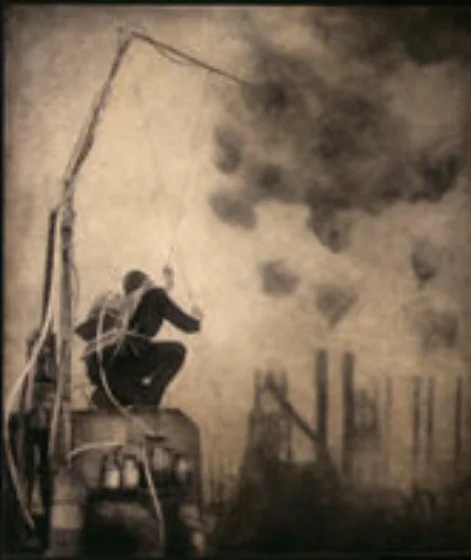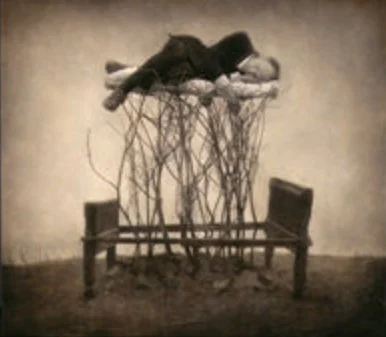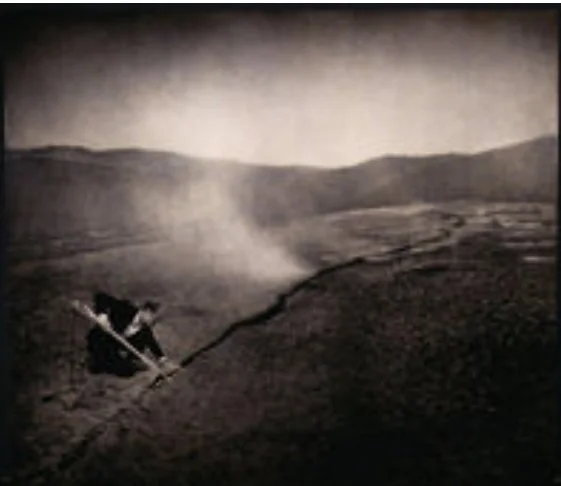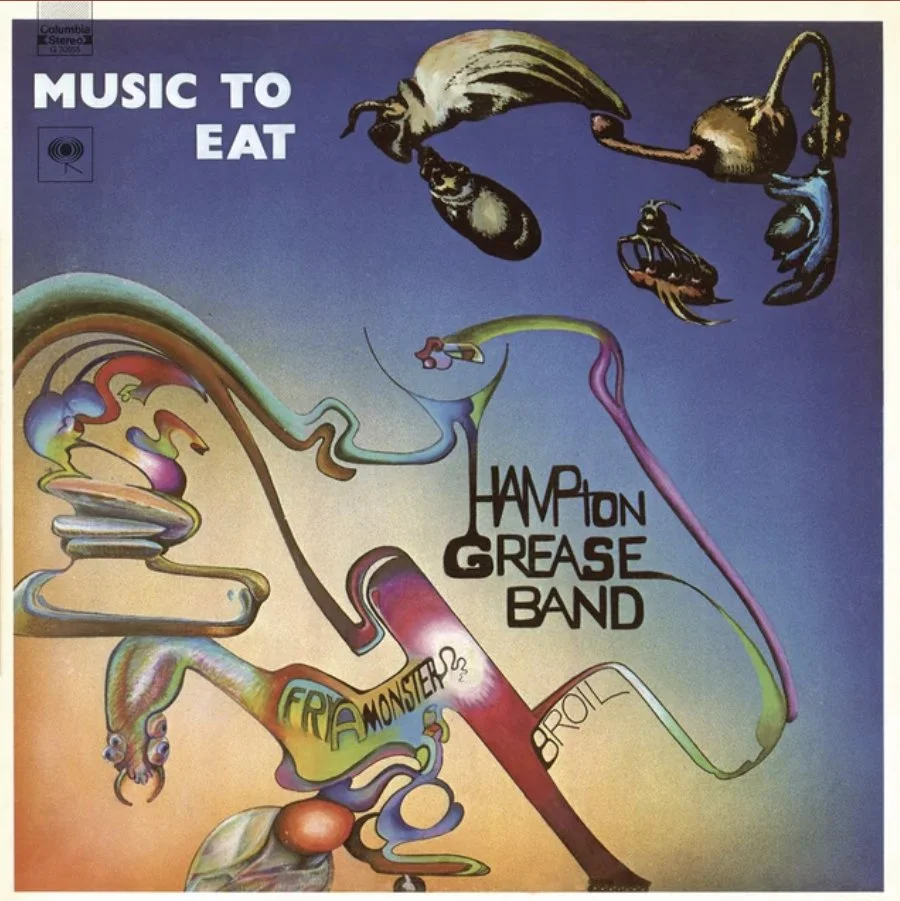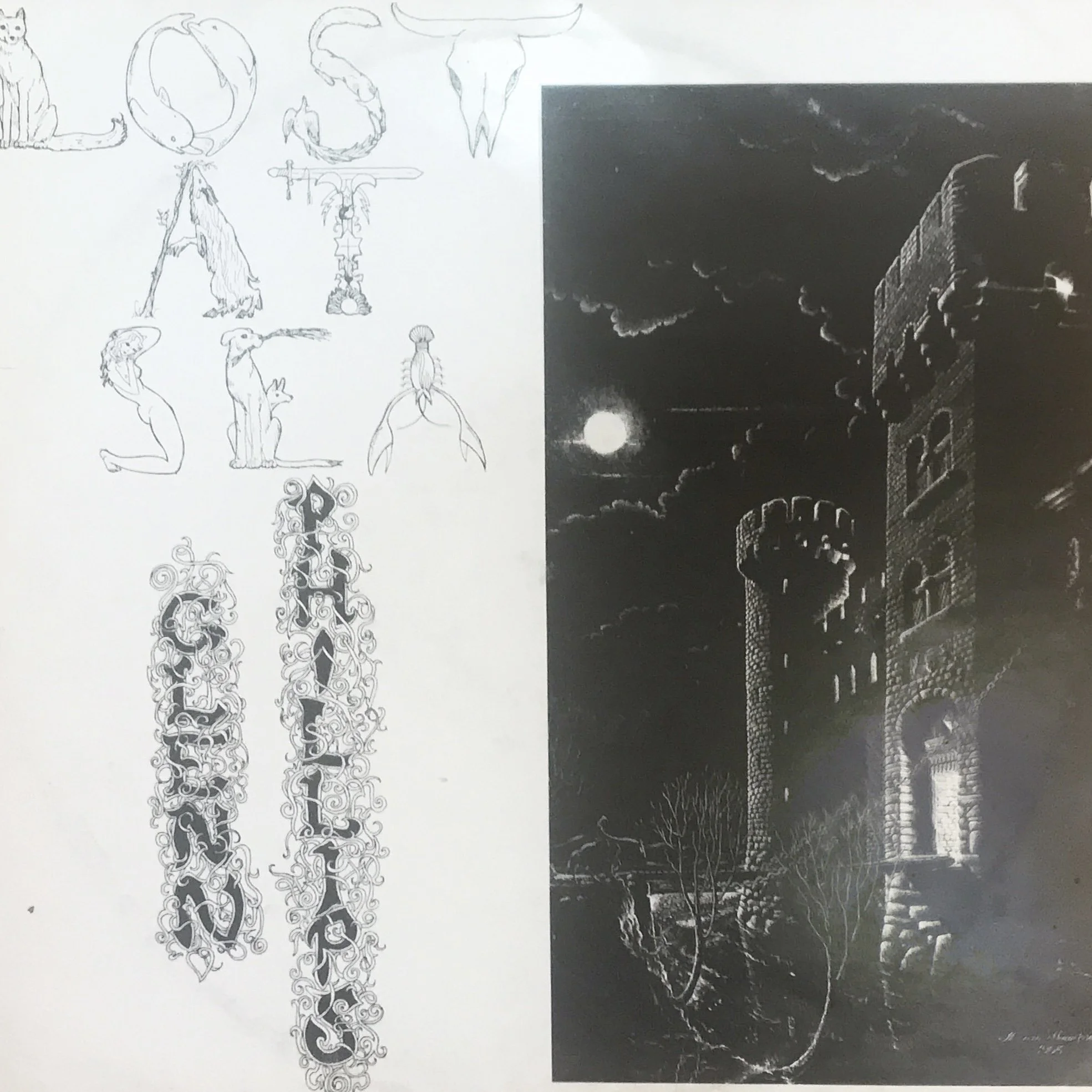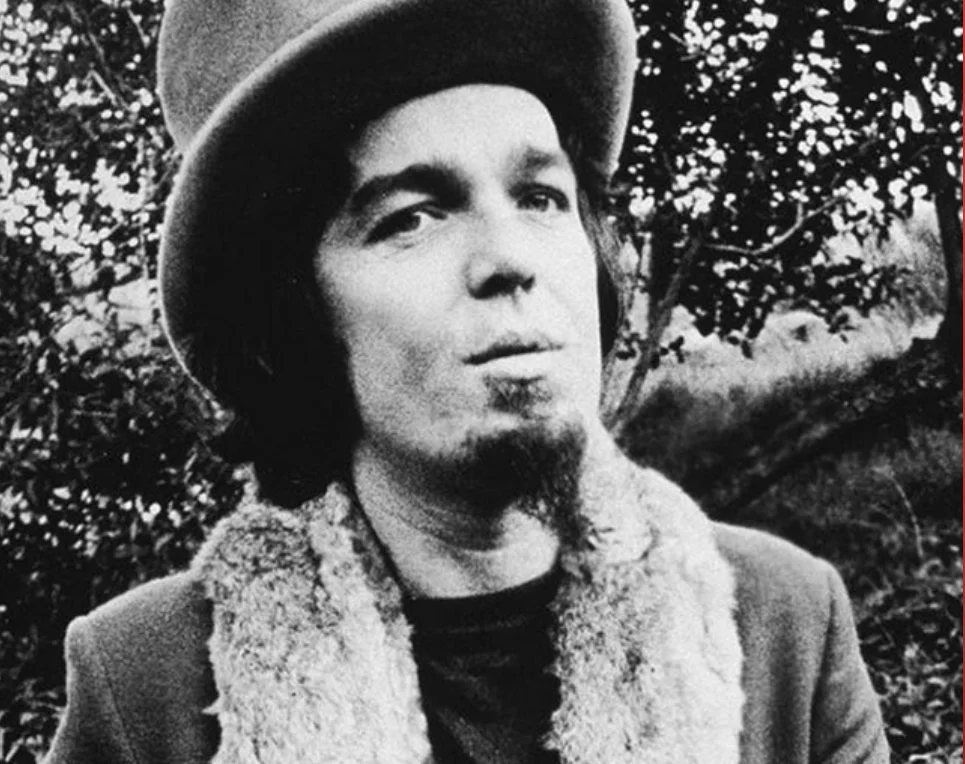Robert and Shana ParkeHarrison photographs
“The Architect’s Brother” 2000.
Arbor Day
Making Rain
Forestbed
“My photographs tell stories of loss, human struggle, and personal exploration within landscapes scarred by technology and over-use…. [I] strive to metaphorically and poetically link laborious actions, idiosyncratic rituals and strangely crude machines into tales about our modern experience.
Robert ParkeHarrison”
Mending the Earth
The ParkeHarrison’s book ends with this indispensible tract from W.S. Merwin
Mr. Merwin
“Start with the leaves, the small twigs, and the nests that have been shaken, ripped, or broken off by the fall; these must be gathered and attached once again to their respective places. It is not arduous work, unless major limbs have been smashed or mutilated. If the fall was carefully and correctly planned, the chances of anything of the kind happening will have been reduced. Again, much depends upon the size, age, shape, and species of the tree. Still, you will be lucky if you can get through this stages without having to use machinery. Even in the best of circumstances it is a labor that will make you wish often that you had won the favor of the universe of ants, the empire of mice, or at least a local tribe of squirrels, and could enlist their labors and their talents. But no, they leave you to it. They have learned, with time. This is men’s work.
It goes without saying that if the tree was hollow in whole or in part, and contained old nests of bird or mammal or insect, or hoards of nuts or such structures as wasps or bees build for their survival, the contents will have to repaired where necessary, and reassembled, insofar as possible, in their original order, including the shells of nuts already opened. With spider’s webs you must simply do the best you can. We do not have the spider’s weaving equipment, nor any substitute for the leaf’s living bond with its point of attachment and nourishment. It is even harder to simulate the latter when the leaves have once become dry — as they are bound to do, for this is not the labor of a moment. Also it hardly needs saying that this the time fro repairing any neighboring trees or bushes or other growth that might have been damaged by the fall. The same rules apply. Where neighboring trees were of the same species it is difficult not to waste time conveying a detached leaf back to the wrong tree. Practice, practice. Put your hope in that.
Now the tackle must be put into place, or the scaffolding, depending on the surroundings and the dimension of the tree. It is ticklish work. Almost always it involves, in itself, further damage to the area, which will have to be corrected later. But, as you’ve heard, it can’t be helped. And care now is likely to save you considerable trouble later. Be careful to grind nothing into the ground.
At last the time comes for the erecting of the trunk. By now it will scarcely be necessary to remind you of the delicacy of this huge skeleton. Every motion of the tackle, every slightly upward heave of the trunk, the branches, their elaborately reassembled panoply of leaves (now dead) will draw from you an involuntary gasp. You will watch for a lead or a twig to be snapped off yet again. You will listen for the nuts to shift in the hollow limb and you will hear whether they are indeed falling into place or are spilling in disorder — in which case, or in the event of anything else of the kind — operations will have to cease, of course, while you correct the matter. The raising itself is no small enterprise, from the moment when the chains tighten around the old bandages until the boles hands vertical above the stump, splinter above splinter. How the final straightening of the splinters themselves can take place (the preliminary work is best done while the wood is still green and soft, but at times when the splinters are not badly twisted most of the straightening is left until now, when the torn ends are face to face with each other). When the splinters are perfectly complementary the appropriate fixative is applied. Again we have no duplicate of the original substance. Ours is extremely strong, but it is rigid. It is limited to surfaces, and there is no play in it. However the core is not the part of the trunk that conducted life from the roots up to the branches and back again. It was relatively inert. The fixative for this part is not the same as the one for the outer layers and the bark, and if either of these is involved in the splintered sections they must receive applications of the appropriate adhesives. Apart from being incorrect and probably ineffective, the core fixative would leave a scar on the bark.
When all is ready the splintered trunk is lowered onto the splinters of the stump. This, one might say, is only the skeleton of the resurrection. Now the chips must be gathered, and the sawdust, and returned to their former positions. The fixative for the wood layers will be applied to chips and sawdust consisting only of wood. Chips and sawdust consisting of several substances will receive applications of the correct adhesives. It is as well, where possible, to shelter the materials from the elements while working. Weathering makes it harder to identify the smaller fragments. Bark sawdust in particular the earth lays claim to very quickly. You must find our own way of coping with this problems. There is a certain beauty, you will notice at moments, in the patterns of the chips as they are fitted back into place. You will wonder to what extent it should be described as natural, to what extent man-made. It will lead you on to speculations about the parentage of beauty itself, to which you will return.
The adhesive for the chips is translucent, and not so rigid as that for splinters. That for the bark and its subcutaneous layers if transparent and runs into the fibers on either side, partially dissolving them into each other. It does not set the sap flowing again but it does pay a kind of tribute to the preoccupations of the ancient thoroughfares. You could not roll an egg over the joints but some of the mine-shafts would still be passable, no doubt. For the first exploring insect who raises its head in the tight echoless passages. The day comes when it is all restored, even to the moss (now dead) over the wound. You will sleep badly, thinking of the removal of the scaffolding that must begin the next morning. How you will hope for sun and a still day!
The removal of the scaffolding or tackle is not a dangerous, perhaps, to the surroundings, as its installation, but it presents problems. It should be taken from the spot piece by piece as it is detached, and stored at a distance. You have come to accept it there, around the tree. The sky begins to look naked as the chains and struts one by one vacate their positions. Finally the moment arrives when the last sustaining piece is removed and the tree stands again on its own. It is as though its weight for a moment stood on your heart. You listen for a thud of settlement, a warning creak deep in the intricate joinery. You cannot believe it will hold. How like something dreamed it is, standing there all by itself. How long will it stand there now? The first breeze that touches its dead leaves all seems to flow into your mouth. You are afraid the motion of the clouds will be enough to push to over. What more can you do? What more can you do?
But there is nothing more you can do.
Others are waiting.
Everything is going to have to be put back.”
“Oh to be summoned by unseen and sparkling eyes
Oh feckless wind there is no word for you that is not praise
This wonder day
There’ll be a bird as red as blood on a breaking branch
The sun will move out from the clouds
And wirly swirl, magnetic waves
One day I’ll realize
The earth is in the sky
The earth is in the sky
Your nightingale knows three notes only
Dreamy sweet notes
Oh spinning, spindle, splendor flies fill
It brings the great increasing
And sorrows end will be our home
Wind in the trees
The earth is in the sky
The earth is in the sky
Your nightingale knows three notes only
Dreamy sweet notes
Valerie I’ve been doing some thinkin
Deep deep thinking
And I’ve come to see that perhaps I’ve not said much
But next time I will untie this tongue of mine
”
Tom Verlaine, guitarist founder of the band Televison, born 12.13.49
Atlanta guitarist Glenn Phillips. In 1971 he was the zany and imaginative player for the Hampton Grease Band who occupied the outskirts of commercial viability on the Columbia Records catalogue. On the art rock scale they were off to the races fired by the free range vocals of one Bruce Hampton. Their double record debut began for instance with “found lyrics” from a Chamber of Commerce promotional material for Halifax, Nova Scotia and facts from perhaps a geography book or road map. And so on!
Then there is the matter of Glenn’s 1977 solo lp “Lost at Sea.” Gathered below from a more recent anthology is one of the gems from the original. I believe it used mariachi music as its conceptual wellspring. He operates from the delicate and lacy to the making of sonic blast-offs.
Bassist Jamaladeen Tcauma
“In 1969, Trout Mask Replica, a double album was released on Frank Zappa’s Straight Records after 8 months of arduous rehearsals. I purchased a copy that summer. The record was a commercial failure in the US but in Rolling Stone magazine’s 2003 list of the 500 greatest albums of all time it was ranked 58th.
I am not absolutely sure of the date of their concert at Clark, but in January of 1972 they performed at Harvard, Yale and in Providence, Hartford and Springfield.
Captain Beefheart (Don Van Vliet) died in 2010 from complications from multiple sclerosis. Members of the Magic Band have been quite critical of the Captain. Drummer John French (Drumbo) from his 2010 memoir Beefheart: Through The Eyes of Magic recounted being “... screamed at, beaten up, drugged, ridiculed, humiliated, arrested, starved, stolen from, and thrown down a half-flight of stairs by his employer.” In explaining some of his strange behavior, Vliet said he was a paranoid schizophrenic, but by all accounts he was a serious taskmaster who abused his musicians verbally and sometimes physically.
Of course I knew none of this at the time and was a big fan of the blues, rock, free jazz and avant-garde compositions he was known for. Various sources say that Beefheart was listening “intensively” to the Delta blues of Son House and Robert Johnson, jazz artists such as Ornette Coleman, John Coltrane, Thelonious Monk and Cecil Taylor, and the Chicago blues of Howlin’ Wolf and Muddy Waters. I’ll never forget what an upperclassman said to me about Cecil Taylor’s music, “His music makes Captain Beefheart sound like Mickey Mouse.” While I came to understand what he meant. For example listen to Taylor’s 1966 Unit Structures and compare it to Beefheart’s music. I continue to appreciate what Beefheart was trying to do with his music and band.
I recall the concert sounding much like his recordings of that period, The Spotlight Kid and Clear Spot, though I wasn’t able to stay for the complete performance due to a companion needing attention due to a bad trip.
”The Dust Blows Forward ‘n The Dust Blows Back”
There’s old Gray with her dove-winged hat
There’s old Green with her sewing machine
Where’s the bobbin’ at?
She’s toting old grain in a printed sack
The dust blows forward and the dust blows back
And the wind blows black through the sky
And the smokestack blows up in the sun’s eye
What am I gonna die?
A white flake riverboat just blew by
Bubbles pop big
And a lip, and a lipstick Kleenex
Hung on a pointed forked twig
Reminds me of the bobby girls
Never was my hobby girls
Handful o’ worms and a pole fishin’
Cork bobbin’ like a hot red bulb
And a blue jay squeaks
His beak open an inch above a creek
Gone fishin’ for a week
Well I put down my bush
And I took off my pants and felt free
The breeze blowin’ up me and up the canyon
Far as I could see
It’s night now and the moon looks like a dandelion
It’s black now and the blackbird’s feedin’ on rice
And his red wings look like diamonds and lice
I could hear the mice toes scamperin’
Gophers rumblin’ in pile crater rock holes
One red bean stuck in the bottom of a tin bowl
Hot coffee from a krimpt up can
Me and my girl named Bimbo Limbo Spam
”
Shemekia Copeland
w/ guitarist, vocalist Alving Youngblood Hart
““There are 40 people in the world and five of them are hamburgers””
Mr. Beefheart painting
